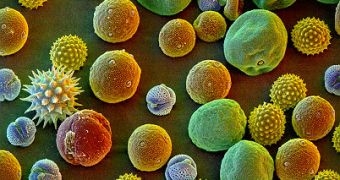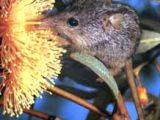The spring, when nature blooms, pollen is everywhere in the air. It is the curse for the allergic people, experiencing the "hay fever". But what's the pollen? The product of the male part of the flowers (stamins), in other words, plant sperm. For a plant to reproduce, the pollen must reach the pistil on the female plant of a flower to fecundate the eggs, a phenomenon called pollination.
Pollination can be crossed (the pollen comes from another plant) or autopollination, the pollen coming from the same plant. For plants, the most beneficial is the cross pollination as it produces plants with a higher genetic diversity, more resistant to environmental factors.
Pollen granules can barely be seen with the free eye. But on a microscope it is easy to see that their size and shape vary from species to species. Because pollen does not rot, the pollen granules often leave behind a "fingerprint" of the vegetation that once covered the area, even tens of millions of years ago. Or what crops were once cultivated in an area. Because the pollen is so different from species to species, plants can make the difference between various types of pollen reaching their pistils.
Plants can pollinate through wind, like in the case of coniferous trees, willows, oaks, birches, poplars, cereals. Because this pollination has a random result, the plants must produce huge amounts of pollen. A sole birch produces 5 million pollen grains through thousands of male flowers. This is the pollen causing the spring allergies. Aquatic plants can use water for transporting the pollen. But these two methods consume a lot of energy.
That's why most flowering plants "employ" carriers, such as insects, birds, and mammals, called pollinators. This pollen is stickier. The plant must lure them with a sugary juice called nectar. While sucking the nectar, the pollinator is filled with pollen which it carries to the next flower it visits for another nectar drink.
In temperate areas, pollinators are almost exclusively insects. The main pollinating insects are the bees. Their hairy bodies are perfect for attracting the pollen. A sole bumble bee can carry on its back 15,000 pollen granules. When bumble bees were introduced in New Zealand during the 19th century, the trifle production boomed, ensuring the base for ship ranching.
For producing one kilogram (2.2 pounds) of honey, bees must 'visit' about 10 million flowers. 30 % of the crop production is ensured by pollinating honey bees. The honey bee is in fact the most important pollinator for humans. Bees have the habit of visiting just the nectar of one species found in abundance around the hive, that's why apicultors are paid by farmers to install their hives in almond, apple, pear, plum, cherry or kiwi plantations.
Adult butterflies feed exclusively on nectar, and many orchid species are pollinated exclusively by butterflies. Some beetles and flies too pollinate, and if you like chocolate, you should know that cocoa tree is pollinated exclusively by a small fly.
In tropical areas, flowers can be pollinated by birds: hummingbirds in Americas, while in tropical Africa-Asia-Australia by honeyeaters, sugarbirds, sunbirds, flowerpeckers and white-eyes. The pollen gets stuck on the feathers around the head and chest.
In tropics, mammals too pollinate. Some of the largest trees on Earth, like the baobab (in Africa and Australia) or kapok (South America) depend on bats for pollination. In Africa-Asia-Australia they are flying-foxes species while in America leaf-nosed bats (related to vampire bats). Some of them eat also the fruits, spreading the seeds too. While most plants attract pollinators through smell or colors, in South America the acacia related Mucuna holtonii use sounds for this. The nectar of this vine function like an "acoustic cat eye", reflecting the ultrasound emitted by the foraging pollinating bats, and helping them to find easier the flowers.
In Australia, some small marsupials, like honey possum (Tarsipes) or "flying" sugar gliders are pollinators feeding on nectar. Their fur fills of pollen while feeding, pollen transported to the next flower.
Plants must signal and lure the pollinators. Some have a landing platform when insects can heat to the sunlight, like in the case of many orchids. A darker color retains heat, that's why most flower in colder areas are red, blue and violet. Another flowers are extremely beautiful or expel perfumed scents to attract pollinators (you wouldn't have thought they do it for the humans' pleasure). Colored dots and stripes signal the pollinator where the nectar is located. Many flowers spread a rotten meat scent to attract pollinating flies and beetles, like the famous Rafflesia, world's largest flower.
Some flowers cheat the pollinators. The orchid bee (Ophrys apifera) imitates perfectly a bee female, so that males (drones) are fooled and attempt to copulate with the flower. Till they catch the trick, they have pollinated several orchids. Some flowers capture the insects and release them only when the pollinators have been loaded with pollen and unloaded their pollen cargo, like in the case of fig trees.

 14 DAY TRIAL //
14 DAY TRIAL // 
